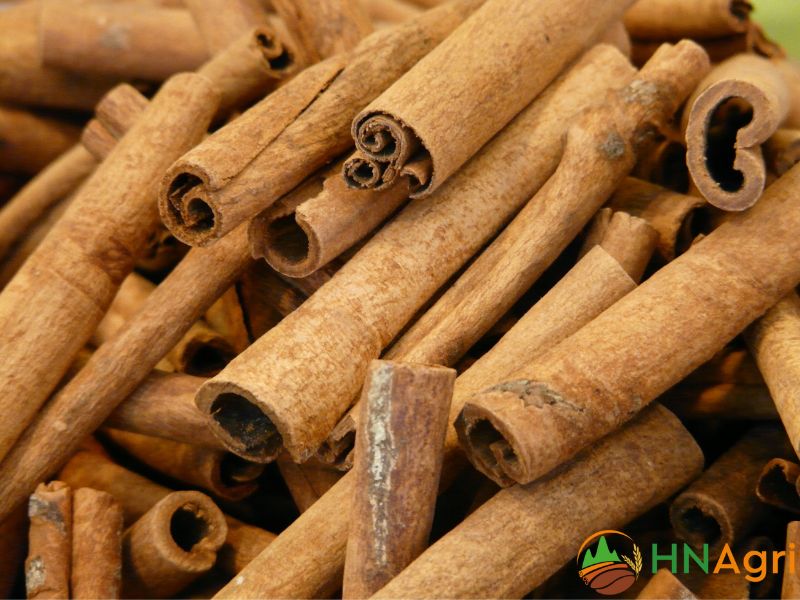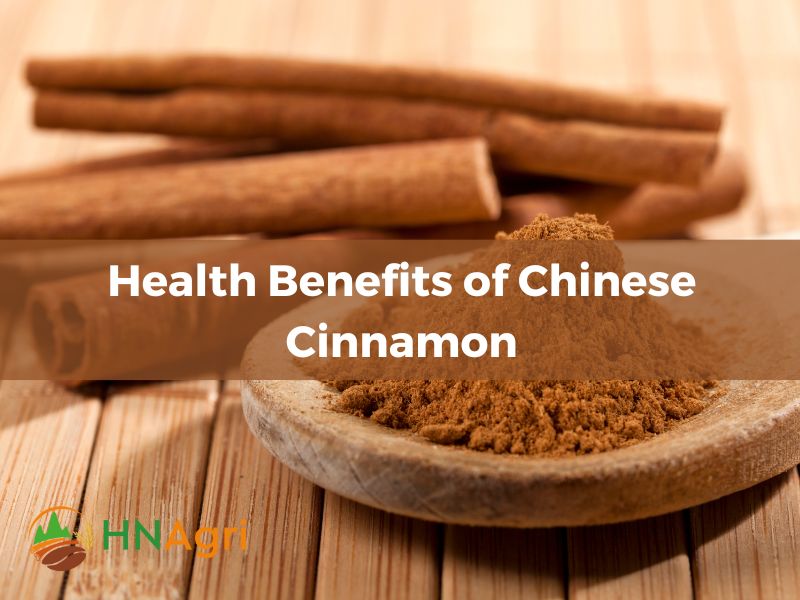Chinese cinnamon, also known as cassia, plays an important role in Chinese food culture. Explore the history, and important role in the culinary culture of Chinese cinnamon in this informative article.
1. History of formation and development of Chinese cinnamon
Chinese cinnamon is a spice with a rich history dating back many centuries. Its distinctive aroma and sweet, warm taste have made it a favorite ingredient in cuisines around the world. Now, we will dive into the history and fascinating origins of this special cinnamon.
1.1.Chinese source of cinnamon
Chinese cinnamon is derived from the cassia Cinnamomum tree, which belongs to the Lauraceae family. Believed to have originated in East Asia, especially China. The Chinese have used cinnamon in their culture and cuisine for thousands of years.
Cinnamon is a small tree about 10-15 meters tall and can live up to hundreds of years. The leaves of the plant are dark green, the fruit when ripe is black. Chinese cinnamon is harvested mainly from the bark, which contains the substance that gives this spice its characteristic flavor and aroma.
1.2. Tradition and development of Chinese cinnamon
Chinese cinnamon has played an important role in China’s history and commerce. In ancient times, Chinese cinnamon became an important commodity on trade routes such as Western Asia and the Western Hemisphere.
The Chinese have used cinnamon for thousands of years and have developed cultivation and processing technologies to improve the quality and yield of Cassia cinnamon.

Tradition and development of Chinese cinnamon
In the past, Chinese cinnamon was prized and considered a unique gift of the Chinese kingdom. It has been awarded as a symbol of wealth and respect. With its wide popularity in different regions of China, it has spread outside and become an important part of Chinese culture and cuisine.
The traditional process and development of Chinese cinnamon involves the application of modern farming technologies to produce high quality Cassia cinnamon. Important factors include soil selection, plant care and protection, and the process of harvesting and processing the bark of the cinnamon tree. To ensure quality, cinnamon bark is usually harvested and processed manually.
1.3. Some key Chinese cinnamon growing areas
Some of the provinces in China with the highest cinnamon production in the country include:
- Sichuan (Sichuan): Sichuan is considered one of the largest cinnamon production centers in China. With diverse terrain and warm climate, Sichuan has favorable conditions for cinnamon cultivation and processing.
- guangdong (Guangdong): Guangdong is also a province with high cinnamon production. With a humid tropical climate, this province has suitable conditions for cinnamon to grow.
- Guangxi (Guangxi): Guangxi is an important cinnamon-producing region of China. With its mountainous terrain and humid tropical climate, Guangxi creates favorable conditions for the cultivation and processing of cinnamon.
- Jiangsu (Jiangsu): Jiangsu is a province located in the east of China and also has a significant production of cinnamon. The province has a temperate climate favorable for cinnamon cultivation.
- Hubei (Hubei): Hubei is a province in China with developed agriculture and cinnamon production. Natural conditions such as the topography and climate in Hubei can produce high-quality cinnamon.
In addition to the above provinces, other provinces such as Hebei (Hebei), Henan (Hunan), Yunnan (Yunnan) and Hunan (Henan) also have significant cinnamon production. The cinnamon production of these provinces has made an important contribution to China’s supply of cinnamon to the domestic and international markets.
2. The role of Chinese cinnamon in traditional Chinese medicine and cuisine
Explore the profound role of Chinese cinnamon in traditional Chinese medicine and its culinary applications. Discover the health benefits, cultural significance and popular cuisines associated with this aromatic spice.
2.1.Chinese Cinnamon in Traditional Chinese Medicine
Chinese cinnamon, known as “Rou Gui” in Mandarin, has been an integral part of traditional Chinese medicine for centuries. It is said to have warming properties and is often used to invigorate the body, improve circulation, and promote overall health.
Chinese cinnamon is known to have a positive effect on the digestive system. It can help stimulate the production of digestive enzymes, increase appetite, and reduce digestive discomfort. In addition, it is often used in herbal formulations to address conditions such as abdominal pain, diarrhea, and nausea.
In traditional Chinese medicine, cinnamon is also prized for its ability to warm the body and dispel colds. It is commonly used during the winter months to relieve symptoms associated with colds, flu, and respiratory congestion. Its warming properties help improve circulation and ease discomfort caused by cold weather.
Furthermore, Chinese cinnamon is said to have properties that help balance the body’s Yin and Yang energies. In Chinese medicine, an imbalance between Yin and Yang is believed to contribute to various health problems.
2.2. Culinary Application of Chinese Cinnamon
Chinese cinnamon is a versatile spice that adds richness and complexity to traditional Chinese dishes. Its distinctive aroma and warm flavor make it a popular ingredient in many recipes.
In traditional Chinese cuisine, Chinese cinnamon is often used in braised dishes, where it infuses meats, poultry, and vegetables with its rich, aromatic essence. It is also commonly used in stir-fries, providing a subtle warmth and enhancing the overall flavor of the dish.
Chinese cinnamon is an essential ingredient in many Chinese soups and broths, giving it its unique aroma and contributing to the overall flavor. It is also used in marinades, sauces, and seasoning mixes to add complexity and depth to flavor.
2.3. Health Benefits of Chinese Cinnamon
Chinese cinnamon possesses a number of health benefits, making it a valuable ingredient in both traditional medicine and modern healthcare practices. Some notable health benefits associated with Chinese cinnamon include:

Health Benefits of Chinese Cinnamon
- Antioxidant properties: Chinese cinnamon is rich in antioxidants, which help fight oxidative stress and reduce inflammation in the body.
- Blood sugar management: Studies have shown that cinnamon can help regulate blood sugar levels by improving insulin sensitivity and enhancing glucose metabolism. This makes it potentially beneficial for people with diabetes or those at risk for it.
- Heart Health: Chinese cinnamon has been linked to promoting heart health. It can help lower blood pressure, lower cholesterol levels and improve blood circulation, thereby reducing the risk of heart disease.
- Anti-inflammatory effects: The active compounds in cinnamon such as cinnamaldehyde have anti-inflammatory properties. This can help reduce inflammation and promote overall health.
2.4. Cultural significance of Chinese cinnamon
Chinese cinnamon has cultural significance in Chinese traditions and festivals. It is often associated with celebrations and symbolic meanings.
During the Lunar New Year, Chinese cinnamon is used in various dishes as a symbol of auspiciousness and luck. It is believed to bring good luck and prosperity to the family, making it an essential ingredient during this festive period.
In addition to its culinary uses, Chinese cinnamon is prized in traditional Chinese herbal remedies. It is incorporated into formulations to enhance efficacy and provide additional therapeutic benefits.
Chinese cinnamon is associated with longevity and vitality in Chinese culture. Its use in traditional medicine and its reputation for promoting overall health have contributed to its esteemed status in Chinese folklore and customs.
3. Compare the taste of Chinese cinnamon and Vietnamese cinnamon
Chinese cinnamon, also known as Cinnamomum cassia, and Vietnamese cinnamon, also known as Cinnamomum loureiroi or Saigon cinnamon, are two popular types of cinnamon with distinct flavors. The following is a taste comparison table of Chinese cinnamon and Vietnamese cinnamon:
Chinese Cinnamon:
- Taste Profile: Chinese Cinnamon has a rich and strong flavor. It is known for its bold, sweet, and slightly spicy flavor. It has a warm and woody aroma with a hint of sweetness.
- Sweetness: Chinese cinnamon tends to be sweeter than Vietnamese cinnamon, so it is preferred in many sweet dishes and desserts.
- Spicy: Chinese cinnamon is moderately spicy. It adds a pleasant warmth and mild heat to dishes without being overpowering.
- Aroma: Chinese cinnamon has a strong and distinct aroma with a combination of sweet, woody and spicy flavors.
Vietnamese Cinnamon:
- Flavor characteristics: Vietnamese cinnamon has a more delicate and complex flavor. It is known for its sweet and slightly spicy taste with subtle floral aromas. It has a warm and sweet aroma.
- Sweetness: Vietnamese cinnamon is slightly less sweet than Chinese cinnamon but still has a natural sweetness that enhances the overall flavor of the dish.
- Spicy: Vietnamese cinnamon has a milder spiciness than Chinese cinnamon. It provides a gentle warmth and a hint of spice without overpowering the palate.
- Aroma: Vietnamese cinnamon has a characteristic aroma with a combination of sweet, floral and spicy notes. It has a stronger aroma than Chinese cinnamon.
See more: Vietnamese Cinnamon vs Ceylon Unveiling the Best Choice
Indonesian Cinnamon A Culinary Treasure That Captivates the Senses
Overall, Chinese cinnamon offers a richer and sweeter flavor, while Vietnamese cinnamon has a more subtle and complex flavor with subtle floral notes. The choice between the two comes down to personal preference and specific culinary applications. Both types of cinnamon add unique and interesting flavors to dishes and have their own appeal in different cuisines and culinary traditions.